HIPAA Compliance Checklist for 2025

Revenue doesn’t stall because people aren’t working hard enough. It stalls because teams are chasing growth with broken processes, disjointed data, and tools that don’t talk to each other.
According to the Salesloft RevOps study, 73% of companies now have a dedicated RevOps leader in the C-suite, showing just how high the stakes have become. And the biggest wins? They come from AI-powered data connectivity that aligns sales, marketing, and finance at the planning stage itself.
This article breaks down 10 AI tools built for RevOps teams that sync deals, sharpen decisions, and grow revenue. You’ll see what each one does, when to use them, and why they matter.
TL;DR - AI Tools for RevOps Teams
What are RevOps Tools?
RevOps tools are software platforms that connect your sales, marketing, and customer success teams so your revenue engine runs without friction.
They eliminate silos, automate repetitive tasks, and give everyone access to clean, unified data that actually drives decisions.
If you're still relying on spreadsheets, manual handoffs, and siloed dashboards, these tools can flip that on its head - fast.
What do RevOps tools help with?
- Data integration: So all teams see the same customer truth.
- Workflow automation: Think instant lead routing, quote creation, and onboarding.
- Performance insights: Forecasting, call analysis, conversion tracking - real-time.
- Sales + marketing alignment: Especially with tools like RevOps HubSpot.
- Team collaboration: Shared systems reduce friction and boost efficiency.
Why Should You Choose RevOps Tools?
RevOps tools help you align sales, marketing, and customer success teams so you can grow revenue without growing chaos.
They break down silos, automate the repetitive stuff, and give you one clear view of your revenue engine so you're not making decisions in the dark.
Let’s break down exactly what you gain from using AI tools for RevOps teams:
Workflows That Run Themselves
Manual tasks waste time and kill momentum. With RevOps data automation, you can:
- Auto-route leads from marketing to sales
- Trigger onboarding once a deal closes
- Eliminate the back-and-forth between teams
Less juggling. More doing.
One Version of The Truth
When your customer data lives in ten tools, nobody knows what’s real. RevOps software gives every team access to the same, unified insights.
That means:
- No more duplicate outreach or mismatched records
- Sales sees what marketing did
- Support knows the full customer journey
You move as one.
Decisions Based on Data, Not Guesses
Gut instincts are fine. But when revenue’s on the line, you need facts.
RevOps tools surface real-time analytics so you can:
- Spot what’s working and what’s not
- Forecast revenue accurately
- Catch pipeline risks before they cost you
Better data. Smarter moves.
A Smoother Customer Experience
When your teams are aligned, your customers feel it. Every interaction from demo request to renewal feels coordinated and responsive.
That leads to:
- Faster response times
- Fewer dropped balls
- Higher retention
Everyone wins.
Built To Scale With You
Whether you’re using RevOps HubSpot, Salesforce, or Syncari, the best revenue operations tools grow with your team. They’re flexible enough to support scaling headcount, expanding GTM motions, and increasing data volume without slowing you down.
Bottom line?
If you want to drive more revenue, with less friction and more visibility, RevOps tools aren’t optional. They’re how modern teams win.
Top 10 RevOps Tools to Choose From
1. Salesforce
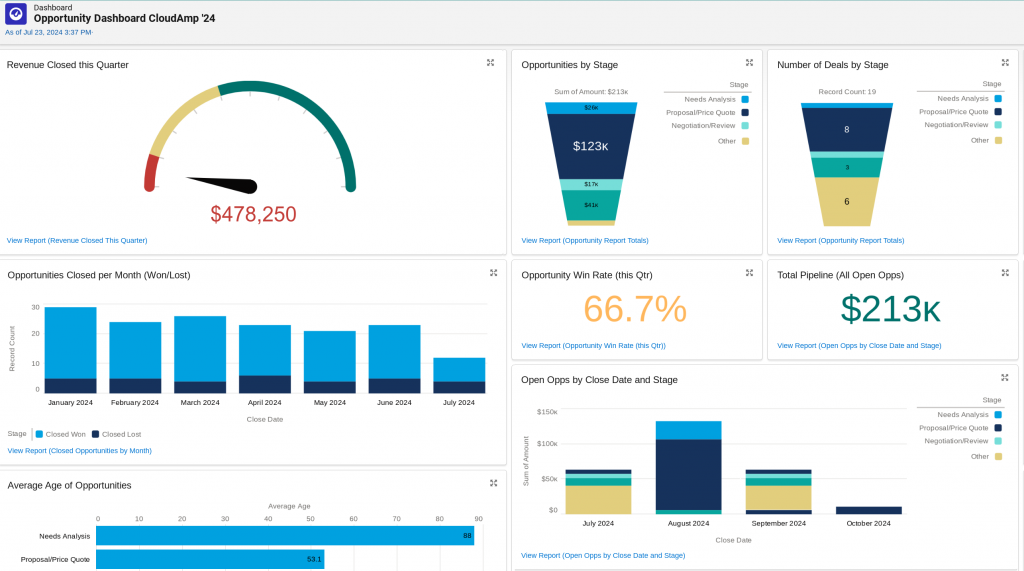
Salesforce helps RevOps teams align sales, marketing, and customer success by centralizing customer data, automating workflows, and improving pipeline visibility. It enables smoother handoffs across departments and offers robust integrations with tools like Slack, Tableau, and third-party revenue platforms. It’s also frequently used as a foundation alongside AI tools for RevOps teams to enable smarter forecasting, routing, and personalization at scale.
Key Features:
- Sales & Marketing Alignment: Real-time visibility into pipeline, campaigns, and deal progress.
- Workflow Automation: Automate lead routing, approvals, and sales tasks across teams.
- Advanced Reporting: Custom dashboards to monitor KPIs across the entire revenue funnel.
Pros:
- Unified view of customer journey
- Extensive RevOps data automation and integration capabilities
- Highly customizable for RevOps needs
Cons:
- Expensive for small teams
- Setup and customization can take time
- Requires training to unlock full potential
Pricing: Starts at $25/user/month (Essentials); most RevOps use cases need Sales Cloud or higher.
2. Syncari
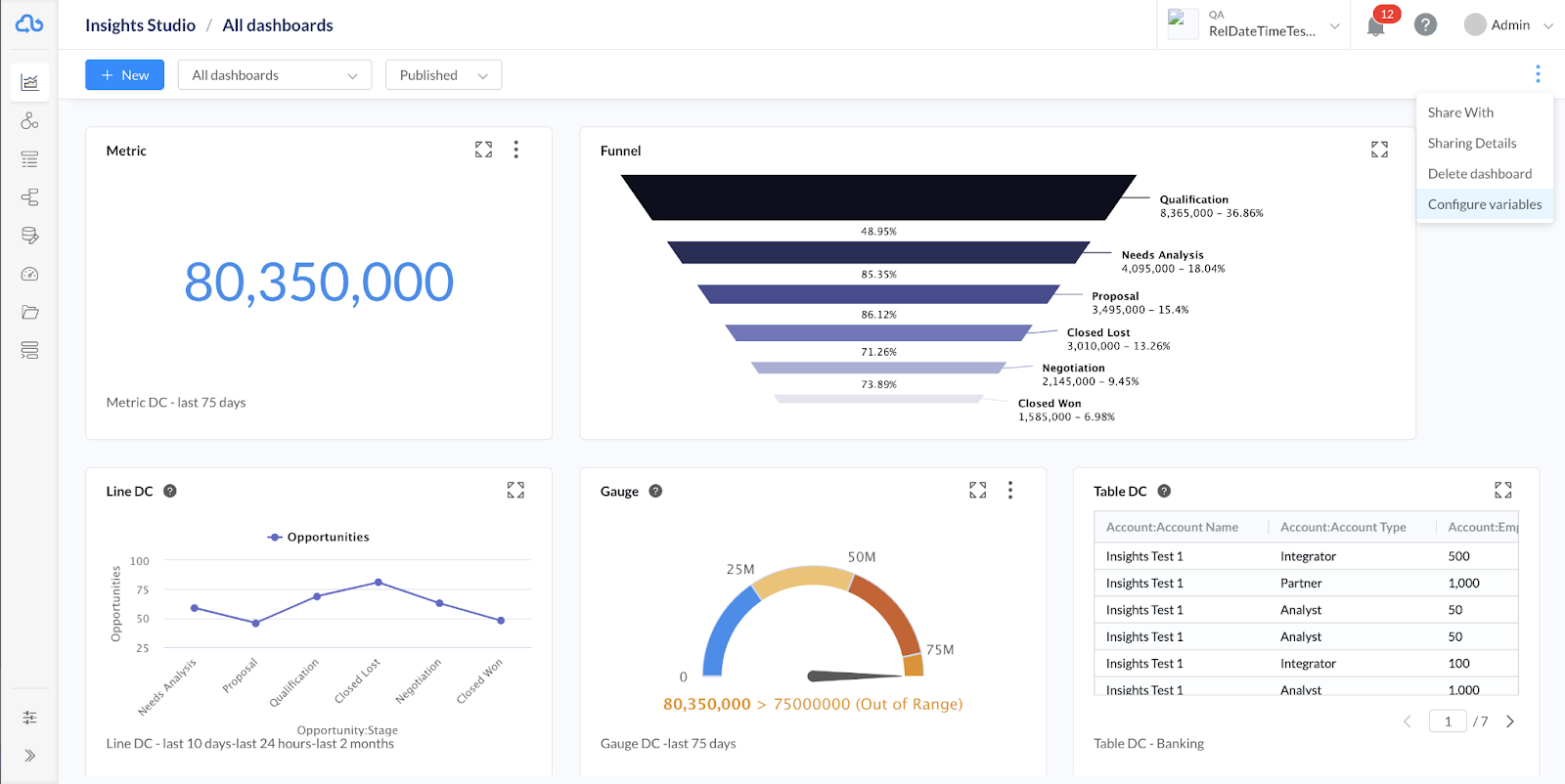
Syncari is especially valuable for RevOps leaders seeking AI tools for RevOps teams that can unify data, automate workflows, and keep GTM systems aligned without writing code. It’s ideal for companies struggling with disconnected systems, duplicate records, and broken handoffs between teams.
Key Features:
- Data unification engine: Clean, standardize, and merge data across CRMs, MAPs, and support platforms.
- Multi-directional sync: Keep customer data accurate and updated across all tools in real-time.
- Workflow automation: Automate lead routing, renewals, attribution, and more using drag-and-drop workflows.
Pros:
- Eliminates data silos between GTM teams
- Built-in data quality and governance tools
- No-code interface for operations teams
Cons:
- Best suited for mid-size to large RevOps orgs
- Limited prebuilt templates compared to older platforms
- Initial setup takes time if data is messy
Pricing: Custom pricing based on number of connected tools and volume.
3. LeanData
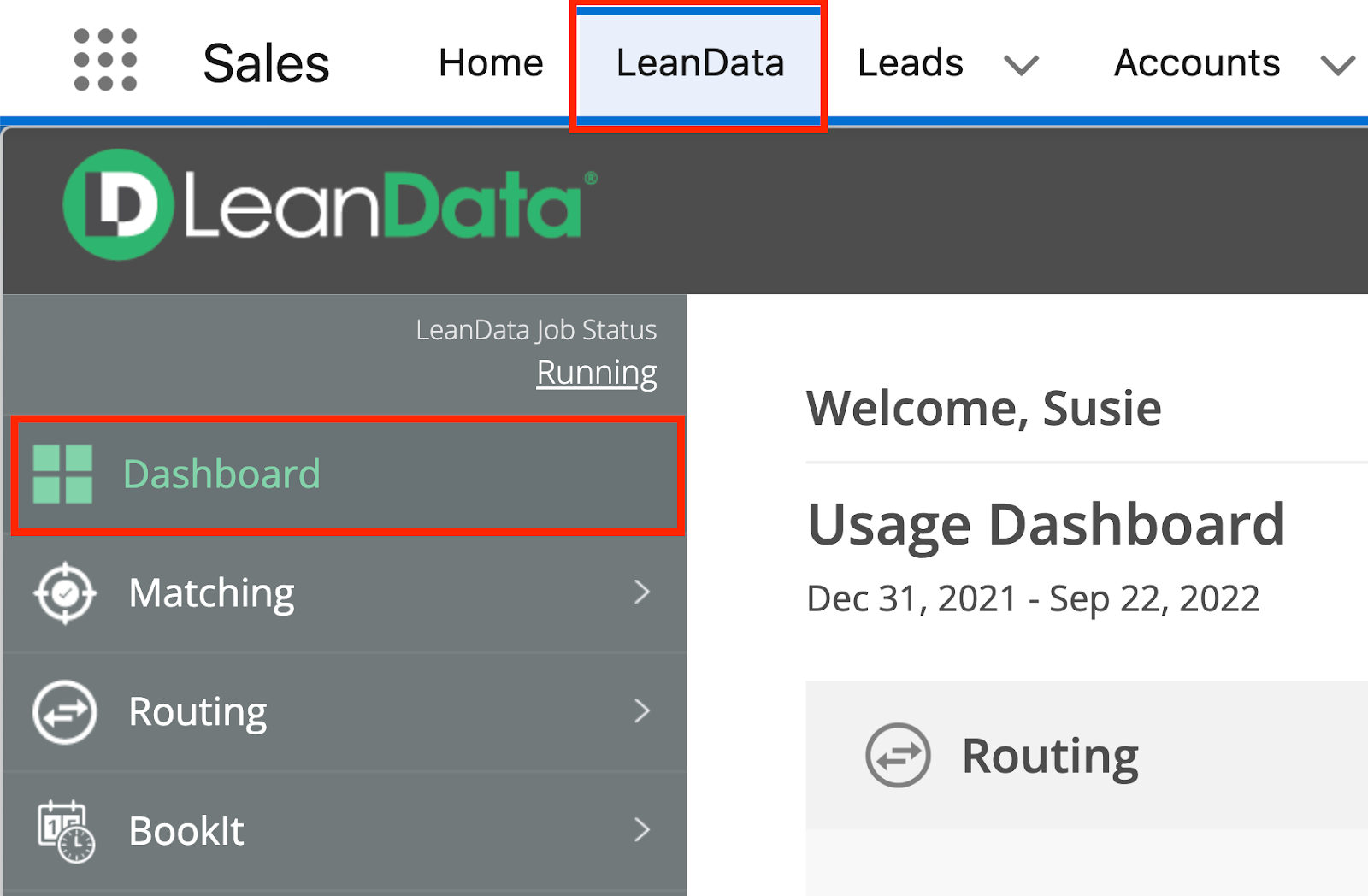
LeanData is a RevOps platform and one of the go-to AI tools for RevOps teams, helping B2B organizations automate lead routing and improve handoffs across marketing, sales, and customer success. It’s known for its flexibility and visual drag-and-drop interface.
Key Features:
- Visual flow builder: Design complex lead routing and sales workflows with a no-code, drag-and-drop interface.
- Territory management: Route leads based on geography, rep assignments, or account ownership for faster follow-up.
- Account matching: Automatically pair leads with the right accounts to improve conversion and reduce duplicates.
- Revenue orchestration: Trigger workflows across systems for lead handoffs, renewals, and pipeline updates.
- CRM integration: Seamlessly connects with Salesforce and other major tools to centralize RevOps processes.
Pros:
- Easy-to-use routing logic without coding
- Helps reduce lead response time
- Supports complex B2B sales processes
Cons:
- Initial setup can be time-consuming
- Requires Salesforce to function fully
- Limited visibility into advanced analytics
Pricing: Custom pricing on request; no public plans listed.
4. Blackthorn
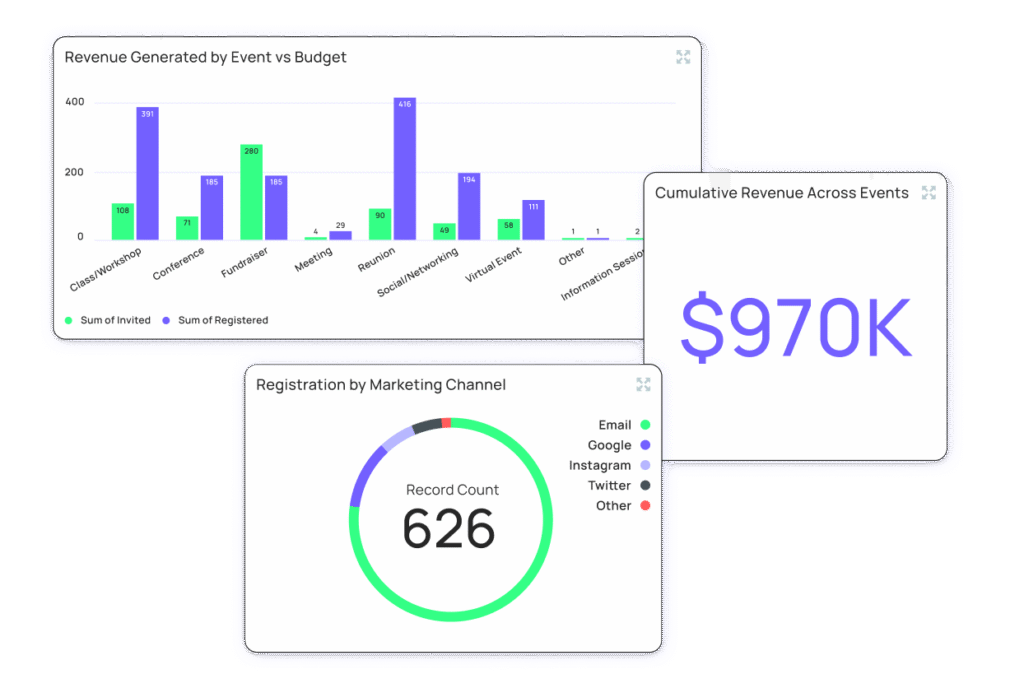
Blackthorn is a native Salesforce app that helps RevOps teams streamline event management, payments, and SMS workflows, all in one place. It’s ideal for teams that want everything tied directly to their CRM.
Key Features:
- Event management: Plan, launch, and track in-person or virtual events inside Salesforce.
- Integrated payments: Collect one-time or recurring payments with Stripe, synced to CRM records.
- SMS automation: Send transactional or marketing texts directly from Salesforce using logic-based triggers.
- Compliance built-in: Automatically manages global tax, GDPR, and HIPAA compliance requirements.
- No-code customization: Modify workflows, forms, and processes without writing a line of code.
Pros:
- 100% native to Salesforce
- Combines events, payments, and SMS in one app
- Real-time CRM sync improves visibility and speed
Cons:
- Only works if you use Salesforce
- Learning curve for non-admins
- Some users report UI can feel clunky
Pricing:
Custom pricing based on the number of users and feature needs; no public plans listed.
5. InsightSquared
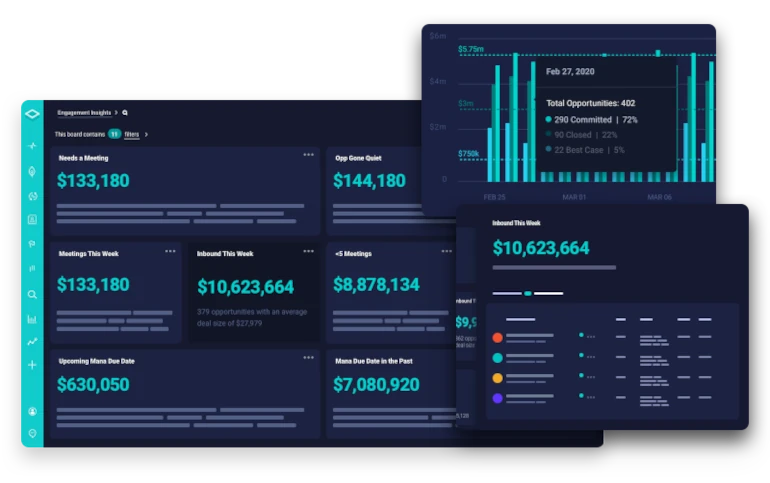
InsightSquared is a no-code revenue intelligence and sales forecasting platform built for growing B2B teams. It helps align revenue operations with accurate, predictive insights and over 350 prebuilt RevOps dashboards. If you're looking for AI tools for RevOps teams focused on predictive forecasting and revenue intelligence, InsightSquared fits the bill.
Key Features:
- Predictive forecasting: ML-powered scoring with fast rollups and flexible hierarchy settings.
- RevOps reporting: 350+ ready-to-use dashboards for pipeline, forecasting, activities, and more.
- Custom dashboards: Drag-and-drop interface to tailor metrics and KPIs for any team.
- CRM integration: Bi-directional sync with Salesforce and other CRMs.
- Ease of use: Intuitive interface that requires minimal training for adoption.
Pros:
- Easy to implement across departments
- Fast, digestible sales insights for reps and leadership
- Saves time on report creation and board prep
Cons:
- Limited real-time sync (2–3 hour data refresh delay)
- Some dashboard customizations require professional services
- Pricing is considered high by smaller teams
Pricing:
Flexible role-based pricing; quote-based on team size and needs.
6. Apollo.io
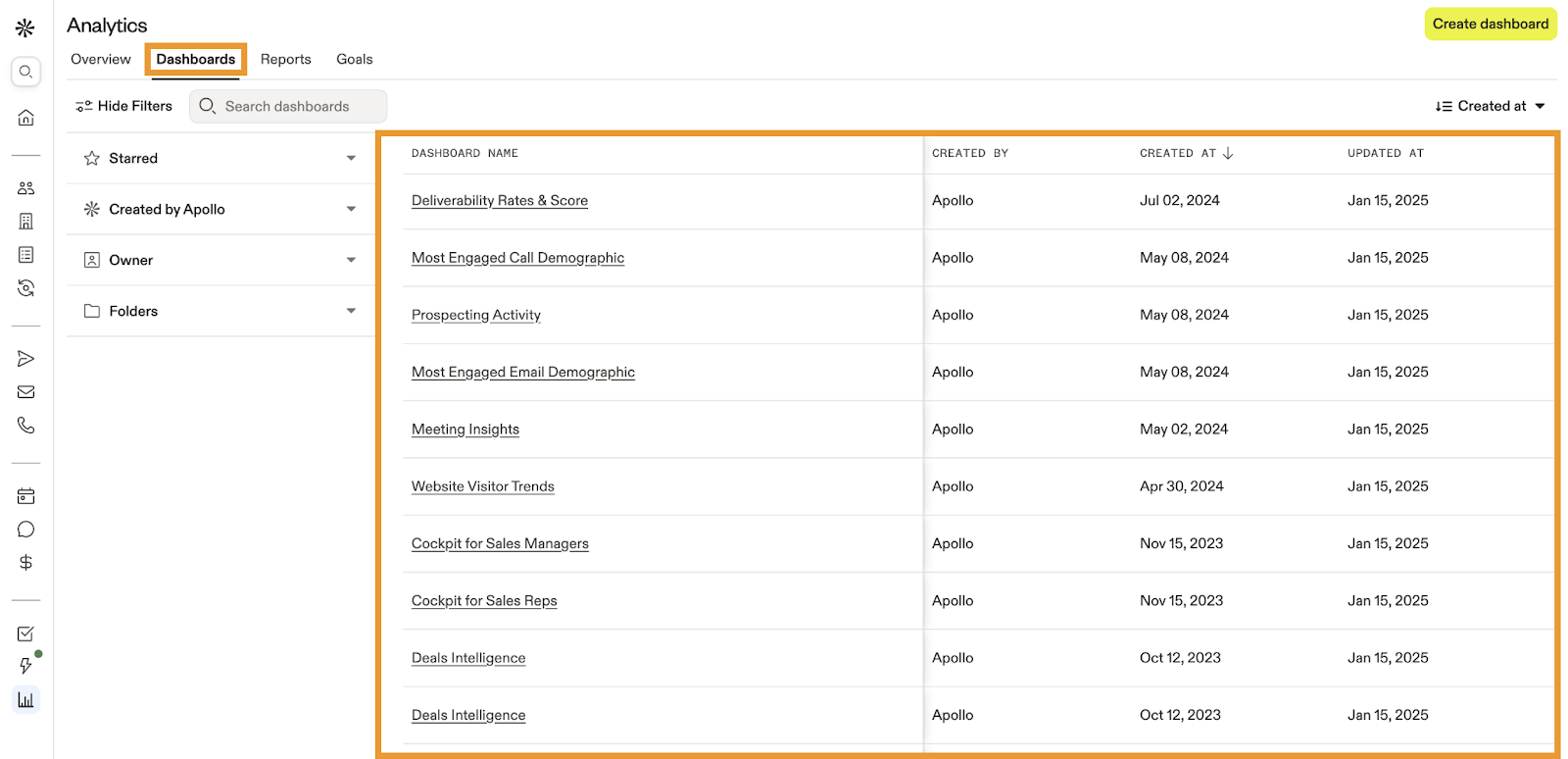
Apollo.io is a go-to-market platform that combines prospecting, engagement, and enrichment in one place. It helps RevOps teams scale outbound efforts and drive pipeline growth with automation and deep intent data. It is one of the most versatile AI tools for RevOps teams, helping them automate prospecting, personalize outreach, and enrich CRM data with minimal effort.
Key Features
- Prospect database: Access 275M+ contacts with verified emails and phone numbers.
- Sales engagement workflows: Build multi-channel outreach sequences with email, call, and LinkedIn steps.
- Buyer intent signals: Identify leads showing high buying intent using AI-powered intent data.
- Enrichment automation: Automatically update CRM records with fresh, accurate data.
- AI email writer: Generate tailored emails for prospects using generative AI.
Pros
- Huge verified contact database
- Affordable for startups and growing teams
- Seamless CRM integrations (HubSpot, Salesforce)
Cons
- Email deliverability can be hit or miss
- UI can lag when handling large lists
- Limited reporting features in lower-tier plans
Pricing: Free plan available; paid plans start at $49/user/month.
7. ZoomInfo
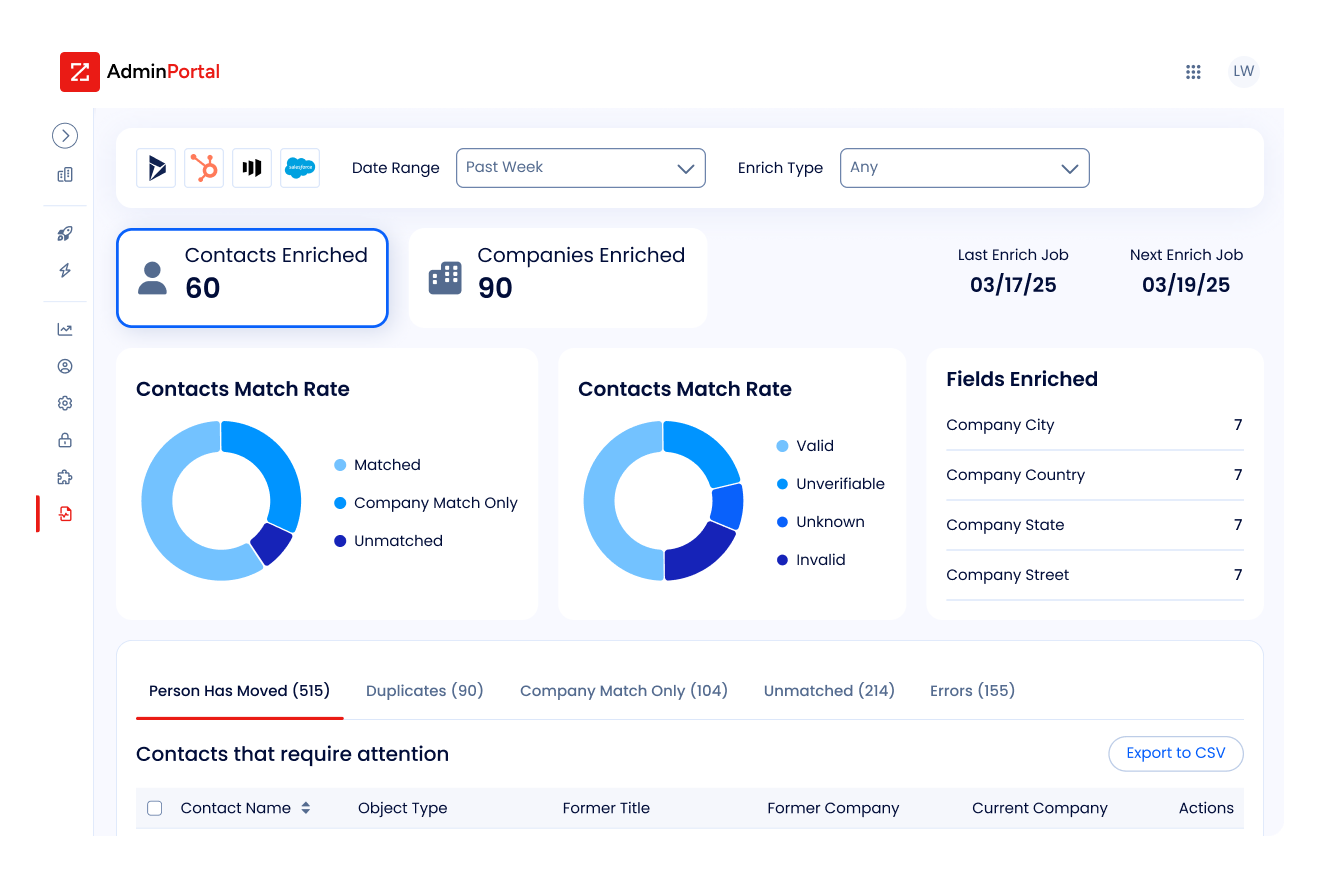
ZoomInfo Operations is a no-code data management platform and one of the leading AI tools for RevOps teams, helping them clean, enrich, and route lead and account data across GTM systems.. It’s designed to reduce manual effort and build a reliable, unified revenue data foundation.
Key Features
- Data enrichment engine: Automatically updates CRM records with accurate contact and company data.
- Deduplication workflows: Identify and remove duplicate records from large datasets.
- CRM integration: Seamless sync with Salesforce, Marketo, and other GTM platforms.
- Lead routing automation: Streamline lead assignment based on rules and triggers.
- Segmentation tools: Build targeted lists using granular company and contact filters.
Pros
- Saves time with powerful enrichment and deduplication
- Strong CRM integration and workflow automation
- Helps prioritize leads with accurate, intent-driven data
Cons
- Setup and onboarding can be complex
- UI is not always intuitive
- Pricing scales fast as usage increases
Pricing: Custom pricing based on usage and package; no free plan.
8. RevOps.io
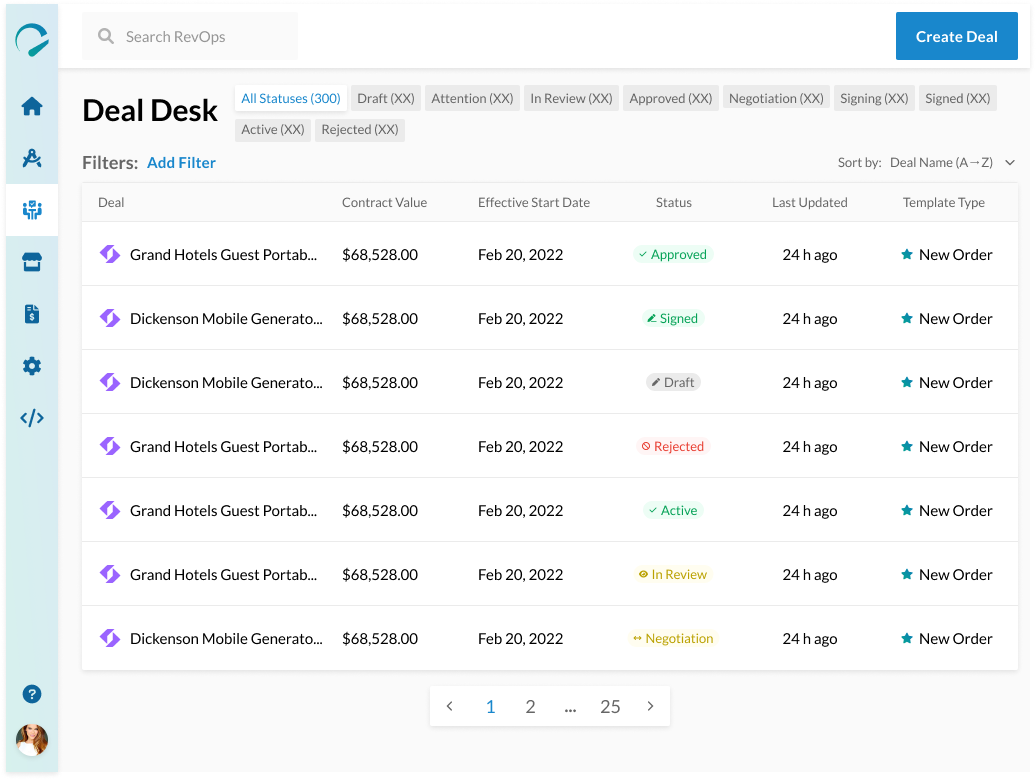
RevOps.io is a quote-to-sign platform designed to streamline sales operations by automating deal desk workflows, approval policies, and quote generation, all while ensuring pricing consistency and contract accuracy.
Key Features:
- Approval workflows: Automate multi-step approvals for discounts, legal, and finance.
- Quote builder: Generate branded, accurate quotes with templates and embedded pricing logic.
- Salesforce integration: Sync quotes and approvals directly with your CRM.
- Contract management: Customize T&Cs and generate legally sound agreements on the fly.
- Audit logs: Track every change for compliance and transparency.
Pros:
- Streamlines approvals without email chains or Slack ping-pong
- Reduces deal errors with built-in guardrails and dynamic pricing
- Makes legal and finance alignment easier with centralized workflows
Cons:
- Initial setup may require RevOps assistance for complex orgs
- Limited customization beyond templated quote blocks
- It may not be ideal for companies without Salesforce
Pricing: Custom pricing based on team size and usage. Free trial available.
9. Aptivio
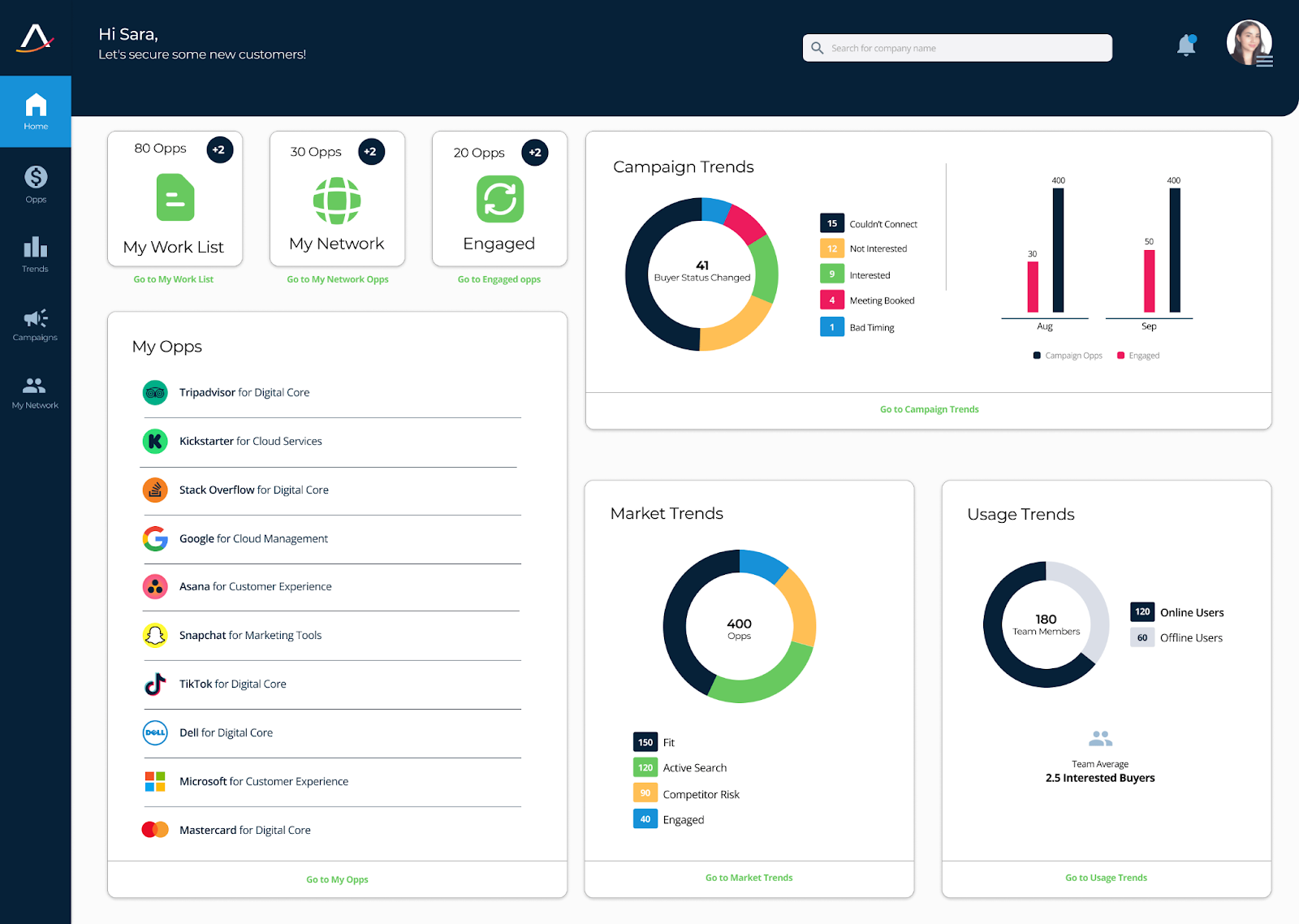
Aptivio is one of the leading AI tools for RevOps teams, helping sales and marketing identify high-intent leads using real-time buyer signals. Its intelligent network selling and automation features make it easier to target, personalize, and close deals faster.
Key Features:
- AI-driven buyer intent signals: Detects real-time signals across the buyer journey for better targeting.
- Network Sales Platform: Helps reps uncover warm intros and shortest paths to decision-makers.
- TargetAI and CloseAI modules: Aligns marketing and sales around pipeline growth.
- Campaign builder & attribution reports: Supports personalized ABM and ROI tracking.
- CRM integrations & Chrome assistant: Streamlines workflows within existing tools.
Pros:
- Boosts pipeline with 25-40% more qualified leads.
- Excellent team support and onboarding experience.
- Effective at surfacing hidden buying opportunities.
Cons:
- UI/UX needs polish; some features feel clunky.
- Learning curve for new users.
- Occasional performance lags in complex queries.
Pricing: Starts at $2,500/month for AI Core Package; CloseAI and other add-ons priced separately.
10. Chorus by ZoomInfo

Chorus is one of the most trusted AI tools for RevOps teams, designed to record, analyze, and surface key insights from sales conversations. It helps teams improve coaching, deal execution, and collaboration across revenue teams by turning calls into actionable data.
Key Features:
- AI-powered call recording & analysis: Automatically captures sales calls and extracts key moments for review.
- Conversation intelligence: Surfaces talk-time, objections, competitor mentions, and next steps.
- Deal tracking: Monitors pipeline health using call data and buyer engagement signals.
- Snippet sharing: Enables teams to clip and share key call moments for coaching or follow-ups.
- CRM integration: Syncs conversation insights with Salesforce and other platforms.
Pros:
- Strong sales coaching and onboarding capabilities.
- Useful for reviewing top-performing reps' talk tracks.
- Seamless integration with sales workflows.
Cons:
- Some users report missed recordings or syncing issues.
- Privacy concerns when call recording isn’t expected.
- UI could use improvements for navigation and filtering.
Pricing: Pricing not publicly available; contact vendor for details.
What are the Three Pillars of RevOps?
The three core pillars of Revenue Operations (RevOps) are People, Process, and Platform. Together, they form the foundation for aligning sales, marketing, and customer success around a shared goal: predictable, scalable revenue growth.
1. People: The RevOps Backbone
This pillar is all about the teams driving revenue like sales, marketing, customer success, and increasingly, finance. But it’s not just about hiring the right roles.
You need aligned KPIs, strong cross-functional collaboration, and clarity around who owns what. Everyone must understand the full revenue funnel, not just their piece of it.
Why it matters: Without alignment across revenue teams, even the best processes and tools can’t fix broken communication or conflicting goals.
2. Process: The Revenue Engine
Your revenue engine depends on repeatable, efficient, and measurable workflows.
From lead handoff and deal stages to renewals and expansion playbooks, this pillar ensures everyone follows a shared blueprint, not siloed motions.
What it looks like when done right:
- Clearly defined lead scoring and routing
- Unified sales and marketing funnel metrics
- Consistent onboarding and retention playbooks
Tip: Automate routine steps using RevOps software to reduce human error and free up time for high-impact work.
3. Platform: The Tech That Ties It Together
This is where RevOps tools and AI software come in. Your platform stack should eliminate data silos and provide real-time visibility into pipeline, performance, and revenue trends.
Think:
- CRM + MAP + Support tools integrated
- AI tools for RevOps teams that surface insights automatically
- Revenue dashboards accessible across departments
Pro Tip: The best RevOps platforms unify data and workflows across the entire customer journey, not just one stage.
What is the Future of RevOps?
RevOps is evolving fast from a support function to a growth-driving strategy team. Powered by AI and unified data, it’s now at the center of business planning, execution, and optimization.
Here’s what the future looks like:
- AI-first operations: Expect smarter forecasting, predictive lead scoring, and automated workflows. AI tools for RevOps teams will reduce manual effort and surface real-time insights across the funnel.
- Unified revenue data: Modern RevOps software will break down data silos, helping teams align around a single view of the customer and act faster on growth opportunities.
- Strategic alignment: RevOps will guide annual planning, territory mapping, and customer lifecycle orchestration, not just clean up ops issues.
- Retention over acquisition: Customer retention, expansion, and churn prevention will become core to the RevOps charter.
- Revenue intelligence: Insights won’t live in dashboards anymore, they’ll be pushed into tools where work happens. Think Slack alerts, automated playbooks, and decision-ready insights.
In short, RevOps is becoming AI-powered, data-driven, and revenue-obsessed, and the teams that adopt early will lead the next wave of growth.
Final Takeaway: Choosing the Right RevOps AI Tool
As RevOps matures into a strategic powerhouse, your tech stack will either fuel growth or slow it down. The right AI tools for RevOps teams are the backbone of alignment, forecasting, and predictable revenue.
But not every tool fits every need.
- If you want a conversation intelligence tool to coach reps and analyze calls, go for Chorus. It’s simple, insightful, and great for sales performance.
- If you want AI-driven lead routing, sales workflows, and revenue orchestration, RevOps.io is your best bet.
- If you’re looking for deep data enrichment and sales intelligence, ZoomInfo still leads the pack.
The best teams don’t just buy tools; they invest in systems that drive outcomes. Choose the one that fits your RevOps maturity and goals.
FAQs
1. How is AI used in revenue operations?
AI in RevOps automates lead scoring, forecasts revenue, analyzes customer data, and personalizes engagement. It helps align sales, marketing, and success teams by delivering insights that boost efficiency and drive predictable growth.
2. What are RevOps tools?
RevOps tools help align sales, marketing, and customer success by centralizing data, automating workflows, and improving reporting. They include CRMs, revenue intelligence platforms, sales enablement, and AI tools for forecasting and pipeline management.
3. What is the difference between CRM and RevOps?
A CRM manages customer relationships, while RevOps is a broader strategy that aligns teams, processes, and tools across the revenue funnel. CRM is a tool; RevOps is a function that ensures data, strategy, and execution are working in sync.
4. What is RevOps in SaaS?
RevOps in SaaS is a strategic function that unifies sales, marketing, and customer success. It ensures teams work from shared data, use aligned processes, and drive recurring revenue by optimizing the entire customer lifecycle and pipeline.
5. What is the difference between RevOps and FinOps?
RevOps focuses on aligning revenue-generating teams, while FinOps manages cloud and SaaS financials. RevOps boosts top-line growth; FinOps optimizes bottom-line efficiency by controlling tech spend and improving ROI through data-driven decisions.
.avif)
%201.svg)







.avif)




.avif)
.avif)




.png)









